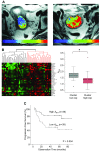Hypoxia in cervical cancer: from biology to imaging
- PMID: 28804704
- PMCID: PMC5532411
- DOI: 10.1007/s40336-017-0238-7
Hypoxia in cervical cancer: from biology to imaging
Abstract
Purpose: Hypoxia imaging may improve identification of cervical cancer patients at risk of treatment failure and be utilized in treatment planning and monitoring, but its clinical potential is far from fully realized. Here, we briefly describe the biology of hypoxia in cervix tumors of relevance for imaging, and evaluate positron emission tomography (PET) and magnetic resonance imaging (MRI) techniques that have shown promise for assessing hypoxia in a clinical setting. We further discuss emerging imaging approaches, and how imaging can play a role in future treatment strategies to target hypoxia.
Methods: We performed a PubMed literature search, using keywords related to imaging and hypoxia in cervical cancer, with a particular emphasis on studies correlating imaging with other hypoxia measures and treatment outcome.
Results: Only a few and rather small studies have utilized PET with tracers specific for hypoxia, and no firm conclusions regarding preferred tracer or clinical potential can be drawn so far. Most studies address indirect hypoxia imaging with dynamic contrast-enhanced techniques. Strong evidences for a role of these techniques in hypoxia imaging have been presented. Pre-treatment images have shown significant association to outcome in several studies, and images acquired during fractionated radiotherapy may further improve risk stratification. Multiparametric MRI and multimodality PET/MRI enable combined imaging of factors of relevance for tumor hypoxia and warrant further investigation.
Conclusions: Several imaging approaches have shown promise for hypoxia imaging in cervical cancer. Evaluation in large clinical trials is required to decide upon the optimal modality and approach.
Keywords: Cervical cancer; Hypoxia; Imaging; Magnetic resonance imaging; Positron emission tomography; Treatment outcome.
Conflict of interest statement
Conflict of interest
The authors, Heidi Lyng and Eirik Malinen, have no conflict of interest to declare.
Ethical standards
This article does not contain any studies with human or animal subjects performed by the any of the authors.
Figures



Similar articles
-
The clinical utility of imaging methods used to measure hypoxia in cervical cancer.Br J Radiol. 2020 Jul;93(1111):20190640. doi: 10.1259/bjr.20190640. Epub 2020 Apr 22. Br J Radiol. 2020. PMID: 32286849 Free PMC article. Review.
-
Changes in Tumor Biology During Chemoradiation of Cervix Cancer Assessed by Multiparametric MRI and Hypoxia PET.Mol Imaging Biol. 2018 Feb;20(1):160-169. doi: 10.1007/s11307-017-1087-5. Mol Imaging Biol. 2018. PMID: 28540524 Free PMC article.
-
Positron emission tomography for radiation treatment planning.Strahlenther Onkol. 2005 Aug;181(8):483-99. doi: 10.1007/s00066-005-1422-7. Strahlenther Onkol. 2005. PMID: 16044216 Review.
-
Molecular imaging (PET) of brain tumors.Neuroimaging Clin N Am. 2009 Nov;19(4):625-46. doi: 10.1016/j.nic.2009.08.012. Neuroimaging Clin N Am. 2009. PMID: 19959009
-
Multiparametric [18F]Fluorodeoxyglucose/ [18F]Fluoromisonidazole Positron Emission Tomography/ Magnetic Resonance Imaging of Locally Advanced Cervical Cancer for the Non-Invasive Detection of Tumor Heterogeneity: A Pilot Study.PLoS One. 2016 May 11;11(5):e0155333. doi: 10.1371/journal.pone.0155333. eCollection 2016. PLoS One. 2016. PMID: 27167829 Free PMC article.
Cited by
-
Combining imaging- and gene-based hypoxia biomarkers in cervical cancer improves prediction of chemoradiotherapy failure independent of intratumour heterogeneity.EBioMedicine. 2020 Jul;57:102841. doi: 10.1016/j.ebiom.2020.102841. Epub 2020 Jun 21. EBioMedicine. 2020. PMID: 32580139 Free PMC article. Clinical Trial.
-
Value of blood oxygenation level-dependent MRI for predicting clinical outcomes in uterine cervical cancer treated with concurrent chemoradiotherapy.Eur Radiol. 2019 Nov;29(11):6256-6265. doi: 10.1007/s00330-019-06198-5. Epub 2019 Apr 23. Eur Radiol. 2019. PMID: 31016443
-
Exploring MiR-484 Regulation by Polyalthia longifolia: A Promising Biomarker and Therapeutic Target in Cervical Cancer through Integrated Bioinformatics and an In Vitro Analysis.Biomedicines. 2024 Apr 19;12(4):909. doi: 10.3390/biomedicines12040909. Biomedicines. 2024. PMID: 38672263 Free PMC article.
-
Summary of the First ISMRM-SNMMI Workshop on PET/MRI: Applications and Limitations.J Nucl Med. 2019 Oct;60(10):1340-1346. doi: 10.2967/jnumed.119.227231. Epub 2019 May 23. J Nucl Med. 2019. PMID: 31123099 Free PMC article.
-
Identification and validation of a prognostic signature related to hypoxic tumor microenvironment in cervical cancer.PLoS One. 2022 Jun 3;17(6):e0269462. doi: 10.1371/journal.pone.0269462. eCollection 2022. PLoS One. 2022. PMID: 35657977 Free PMC article.
References
-
- Hockel M, Schlenger K, Aral B, Mitze M, Schaffer U, Vaupel P. Association between tumor hypoxia and malignant progression in advanced cancer of the uterine cervix. Can Res. 1996;56:4509–4515. - PubMed
-
- Lyng H, Sundfor K, Trope C, Rofstad EK. Disease control of uterine cervical cancer: relationships to tumor oxygen tension, vascular density, cell density, and frequency of mitosis and apoptosis measured before treatment and during radiotherapy. Clin Cancer Res. 2000;6:1104–1112. - PubMed
Publication types
LinkOut - more resources
Full Text Sources
Other Literature Sources
